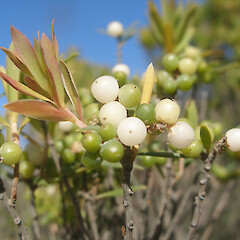Leucopogon parviflorus
Common name
Chatham Island mingimingi
Synonyms
Cyathodes parviflora (Andrews) Allan, Leucopogon lanceolatus R.Br. (nom. illegit.), Leucopogon richei (Labill.) R.Br., Styphelia parviflora Andrews, Styphelia richei Labill.
Family
Ericaceae
Flora category
Vascular – Native
Endemic taxon
No
Endemic genus
No
Endemic family
No
Structural class
Trees & Shrubs - Dicotyledons
NVS code
The National Vegetation Survey (NVS) Databank is a physical archive and electronic databank containing records of over 94,000 vegetation survey plots - including data from over 19,000 permanent plots. NVS maintains a standard set of species code abbreviations that correspond to standard scientific plant names from the Ngä Tipu o Aotearoa - New Zealand Plants database.
LEUPAR
Chromosome number
2n = 22
Current conservation status
The conservation status of all known New Zealand vascular plant taxa at the rank of species and below were reassessed in 2017 using the New Zealand Threat Classification System (NZTCS) – more information about this can be found on the NZTCS website. This report includes a statistical summary and brief notes on changes since 2012 and replaces all previous NZTCS lists for vascular plants.
Please note, threat classifications are often suggested by authors when publications fall between NZTCS assessment periods – an interim threat classification status has not been assessed by the NZTCS panel.
- Conservation status of New Zealand indigenous vascular plants, 2017 . 2018. Peter J. de Lange, Jeremy R. Rolfe, John W. Barkla, Shannel P. Courtney, Paul D. Champion, Leon R. Perrie, Sarah M. Beadel, Kerry A. Ford, Ilse Breitwieser, Ines Schönberger, Rowan Hindmarsh-Walls, Peter B. Heenan and Kate Ladley. Department of Conservation. Source: NZTCS and licensed by DOC for reuse under the Creative Commons Attribution 4.0 International licence.
2017 | At Risk – Naturally Uncommon | Qualifiers: RR, SO
Previous conservation statuses
2012 | At Risk – Naturally Uncommon | Qualifiers: RR, SO
2009 | At Risk – Naturally Uncommon | Qualifiers: OL, SO
2004 | Range Restricted
Brief description
Bushy prickly shrub bearing hard narrow sharp leaves that are greenish underneath and short spikes of small white bell-shaped flowers and white fruit inhabiting the Chatham Islands. Leaves 10-15mm long by 4-6mm wide. Flowers hairy inside, bell-shaped, in clusters of spikes towards tip of twigs.
Distribution
Indigenous. New Zealand: Chatham Island. Present in Australia (southern Queensland, New South Wales, Victoria, South Australia and Tasmania).
Habitat
Strictly coastal. Usually on stable, sand dunes, dune slacks and sand flats, more rarely on sandy soils in pasture. Also rocky headlands, at the head of ravines and in low, windswept coastal scrub where it may be dominant. Prefers free-draining substrates and avoids permanently damp soils.
Detailed description
Shrub 0.8-1.0(-3) × 1.0-1.8(-2.0) m. Trunk stout, often with several arising from ground level, bark firm, furrowed, ± tessellated, dark grey-black or brown. Branches and branchlets numerous, virgate, crowded, glabrous. Leaves numerous, ± weakly appressed to erecto-patent, crowded toward branch apices, glabrous, lanceolate, oblanceolate to elliptic, apex ± attenuate, rounded to subacute, with a small apical callus, base attenuate; 10-15(-20) × 4-6(-8) mm, flat or slightly convex with recurved, entire margins, veins faint, parallel, more evident when dried; lamina pale yellow-green to dark green above, paler beneath, with the foliage of young growth and exposed plants often adaxially glaucescent. Inflorescences axillary or terminal in upper leaf axils, spicate; spikes densely crowded, 15-20 mm long; flowers sweetly scented, densely packed, crowded,. Bracts and bracteoles broadly ovate, bracteoles weakly keeled, c.½ as long calyx. Sepals ovate, acute, 1.5-2.5 mm long, finely ciliolate. Corolla tube ± cylindrical, about as long as sepals, white or pale pink, corolla lobes 1.5-1.9 mm long, white or pale pink at anthesis, fading to white with age, deltoid to narrowly triangular, reflexed, inner surface densely invested in white hairs (bearded). Anthers versatile, half exserted, 1.5 mm long, with sterile tip 0.3-0.5 mm long. Ovary 4-5-locular, c.1 mm long, tapering into a short style; style not exserted. Fruit a fleshy, ovoid or spherical drupe 3 mm diameter, immature flesh at first greenish-yellow, then pale yellow, maturing white. Endocarp elliptic to broadly elliptic, 3-angled, rarely biconvex or 4-angled. 2.2-3.5 × 1.8-2.3 mm, indistinctly longitudinally ridged or veined, surface light orange-yellow, orange or orange-brown, internally with 2-4 cells with up to 3 filled.
Similar taxa
None on the Chatham Islands. However, this species has been confused in cultivation and occasionally on Chatham Island with Pouteretere (Leptecophylla robusta), which differs by its leaves which are dark green, purple-green or bronze-green above, pale green or cream below (rather than yellow-green to dark green above, paler beneath), and ovate or oblong (rather than lanceolate, oblanceolate to elliptic), flowers which are solitary rather than in spikes, and fruit which is larger (5-8 mm cf. 3 mm diameter) and red, pink or white. North Cape, North Island records of this species are referable to L. xerampelinus.
Flowering
Throughout the year
Flower colours
White
Fruiting
Throughout the year
Life cycle
Fleshy drupes are dispersed by frugivory (Thorsen et al., 2009).
Propagation technique
Easily grown from fresh seed. Can also be grown from semi-hardwood cuttings though these can be slow to strike. An attractive shrub that does well in exposed sandy soils and is very drought tolerant.
Threats
A Naturally Uncommon, Range-restricted species abundant along the sandy coastline of Chatham Island. It is not especially palatable however, at some sites it may be threatened by marram grass (Ammophila arenaria)
Etymology
leucopogon: White beard (the petals are hairy)
parviflorus: Small flowers
Attribution
Fact Sheet prepared for NZPCN by P.J. de Lange 30 December 2010. Description prepared from Chatham Island herbarium specimens and live material.
References and further reading
Thorsen, M. J.; Dickinson, K. J. M.; Seddon, P. J. 2009. Seed dispersal systems in the New Zealand flora. Perspectives in Plant Ecology, Evolution and Systematics 11: 285-309
NZPCN Fact Sheet citation
Please cite as: de Lange, P.J. (Year at time of access): Leucopogon parviflorus Fact Sheet (content continuously updated). New Zealand Plant Conservation Network. https://www.nzpcn.org.nz/flora/species/leucopogon-parviflorus/ (Date website was queried)







